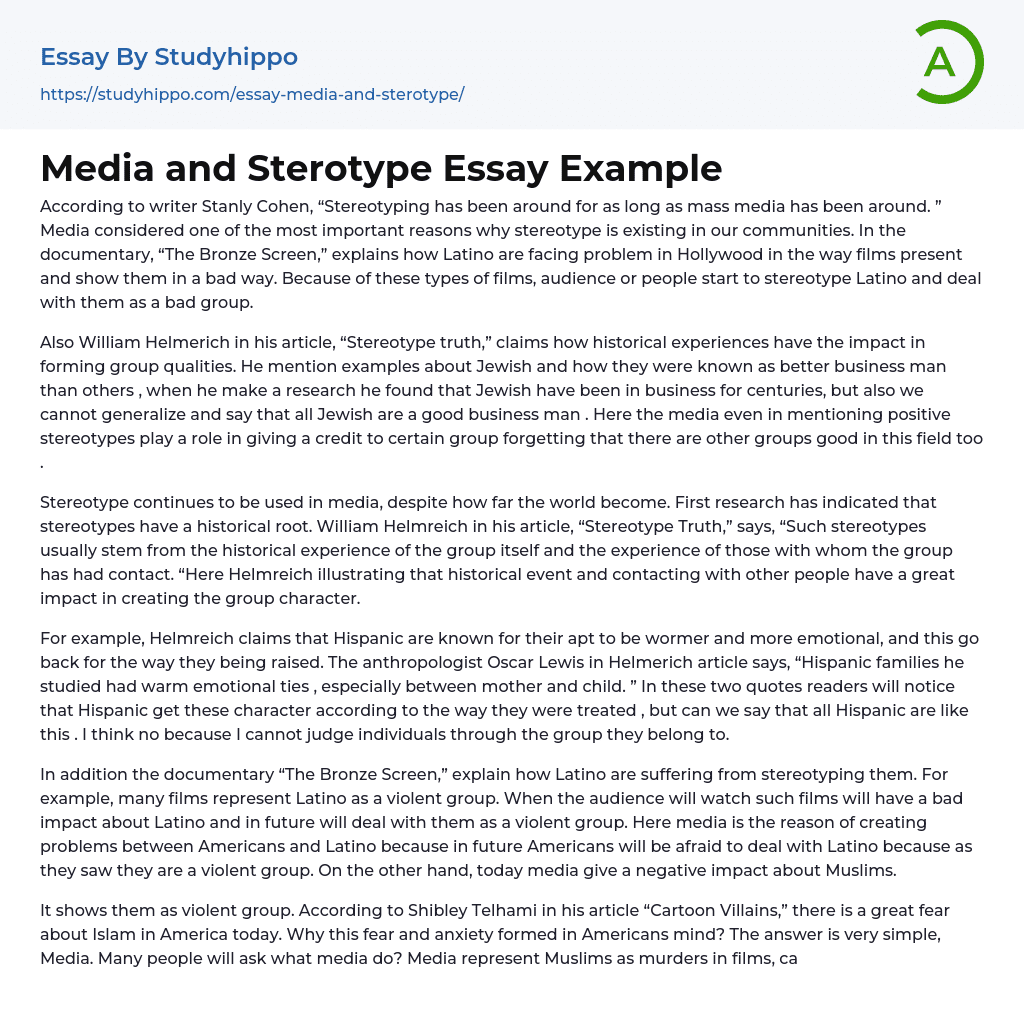According to writer Stanly Cohen, stereotypes have existed since the rise of mass media. Many people believe that the media greatly contributes to the perpetuation of stereotypes in our society. An illustration of this can be seen in the documentary "The Bronze Screen," which demonstrates how Hollywood consistently portrays Latinos negatively, resulting in challenges for this community. As a result, audiences who are exposed to these films tend to form negative perceptions and stereotype Latinos.
In his article "Stereotype truth," William Helmerich argues that historical experiences shape group qualities. He provides examples of the perception that Jewish people are better businesspeople, but acknowledges that not all Jewish individuals can be generalized as such. Helmerich emphasizes that the media should remember that other groups also excel in this field, even when mentioning positive stereotypes.
Despite the advanceme
...nts achieved globally, stereotypes continue to exist in the media. According to research, stereotypes are rooted in historical factors. In his article "Stereotype Truth," William Helmreich suggests that these stereotypes often stem from a group's own history and interactions with others. This highlights how historical events and interactions greatly influence the identity of a group.
According to Helmreich, Hispanics are often characterized as being more affectionate and expressive due to their cultural upbringing. In a piece by Helmreich, anthropologist Oscar Lewis observed that Hispanic families he studied exhibited strong emotional bonds, especially between mothers and children. These excerpts suggest that these characteristics are acquired through interactions rather than being inherent in all Hispanics. Therefore, it is unfair to make judgments about individuals solely based on their ethnic background.
"The Bronze Screen" documentary examines th
impact of stereotyping on Latinos and its detrimental effects on how they are perceived. Numerous movies portray Latinos as a violent community, which leads viewers to develop a similar perception. This media representation further widens the divide between Americans and Latinos, as Americans become wary of engaging with them due to their association with violence. Moreover, the media also perpetuates negative stereotypes about Muslims in today's society.
The text suggests that there is a prevailing portrayal of Islam as a violent and dangerous group in America. Shibley Telhami's article "Cartoon Villains" explores the reasons behind this fear and anxiety. According to Telhami, the media plays a significant role in shaping these negative perceptions by depicting Muslims as murderers in movies, cartoons, and newspapers. Additionally, the media often portrays Muslims as members of a terrorist organization.
The issue is that certain groups associated with terrorism and Islam receive a disproportionate amount of attention from the media. As a result, spectators often perceive all Muslims as terrorists due to the focus on these particular groups. According to Telhami, this tendency to conflate terrorist groups like the Taliban with Muslims or Arabs is unjust as it wrongly generalizes innocent individuals with bad ones. Rather than solely highlighting the negative aspects of a specific group, I urge the media to also showcase their positive attributes.
In conclusion, despite the progress reached by the world today, stereotypes still continue to be used in the media. The article "Stereotype Truth" by William Helmbrich presents an important claim that stereotypes have a historical basis. Helmbrich attempts to establish a connection between the history of certain groups, such as Hispanic individuals, and
the reasons why they are often labeled as emotional. according to Helmbrich's findings, this can be attributed to the upbringing of Hispanic individuals, as research suggests that Hispanic families have warm and emotional relationships, particularly between mothers and children.
The documentary "The Bronze Screen" addresses the detrimental portrayal of Latinos in cinema, depicting them as a violent group and creating a negative image in the minds of the audience. Judging others without personal acquaintance is a form of injustice, as people form opinions based solely on information from television or newspapers without verification. Even if these portrayals are accurate, it is not fair to judge an entire group based on the actions of individuals.
- Quran essays
- Al-Qaeda essays
- Muhammad essays
- Muslim essays
- Ali essays
- Ramadan essays
- Taliban essays
- Osama Bin Laden essays
- Sep-11 essays
- Afterlife essays
- Atheism essays
- Bible essays
- Buddhism essays
- Christian Worldview essays
- Christianity essays
- Confession essays
- Cosmological Argument essays
- Deism essays
- Devil essays
- Existence of God essays
- Faith essays
- Freedom Of Religion essays
- God essays
- Hinduism essays
- Immortality essays
- Islam essays
- Jainism essays
- Jews essays
- Judaism essays
- Miracle essays
- Monk essays
- Monotheism essays
- New Testament essays
- Old Testament essays
- Pilgrimage essays
- Puritans essays
- Revelation essays
- Ritual essays
- Salvation essays
- Sin essays
- Sinners essays
- Soul essays
- Taoism essays
- Temple essays
- Theology essays
- American Literature essays
- Between The World and Me essays
- Book Report essays
- Book Review essays
- Book Summary essays




